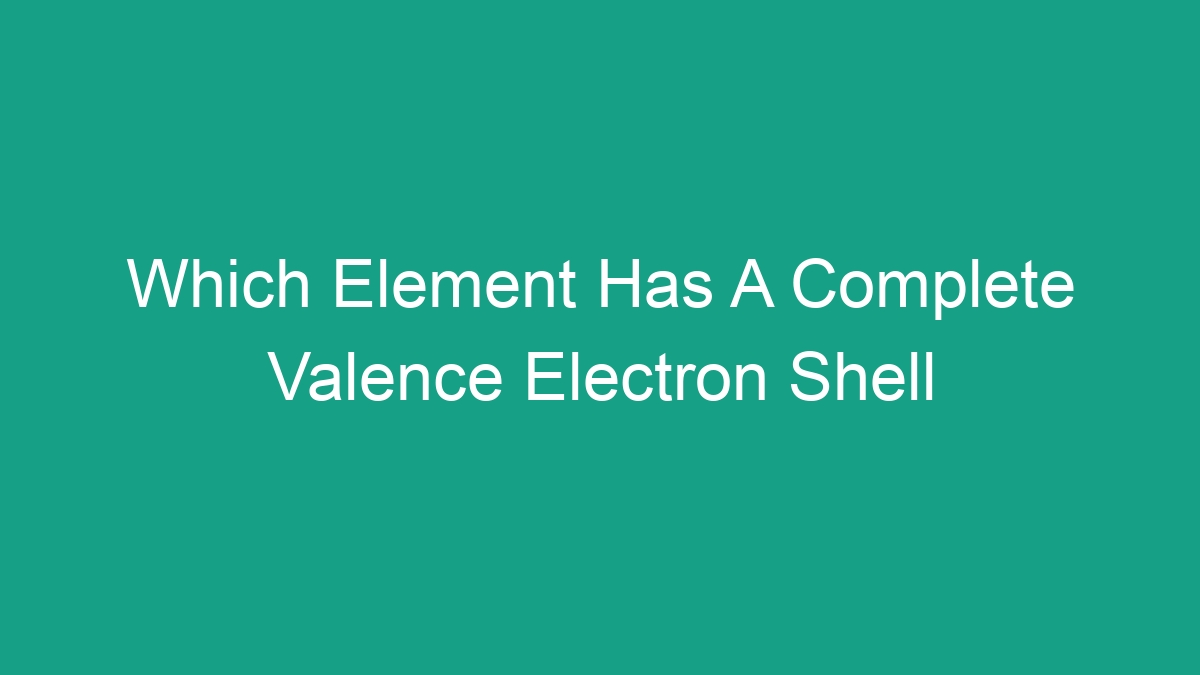
When it comes to understanding the properties of chemical elements, one of the crucial concepts is their valence electron configuration. Valence electrons are the electrons in the outermost energy level of an atom, and they play a significant role in determining an element’s chemical behavior. A complete valence electron shell is one that has achieved stability through a full outer electron shell, which is typically the goal for atoms. In this article, we will explore which element has a complete valence electron shell and its significance in chemistry.
Understanding Valence Electron Shells
Before delving into which element has a complete valence electron shell, it’s essential to understand the concept of valence electron shells. In an atom, electrons are arranged in energy levels, with the outermost energy level determining the atom’s reactivity. The outermost energy level can hold a certain number of electrons, and atoms strive to achieve a full outer shell to attain stability, akin to the noble gases.
The number of valence electrons an element possesses can greatly influence its chemical properties. Elements with a complete valence electron shell are typically stable and less likely to form chemical bonds with other atoms. On the other hand, elements with incomplete valence electron shells are more reactive and tend to form bonds to achieve a full shell.
Elements with Complete Valence Electron Shells
Now, let’s identify which element has a complete valence electron shell. A complete valence electron shell corresponds to achieving the electron configuration of the nearest noble gas. The noble gases, also known as the inert gases, are located in the far right column of the periodic table and are known for their stability due to their full outer electron shells.
The noble gases include:
- Helium (He): Helium has two electrons in its outer shell, making it the only element with a complete valence electron shell with just two electrons.
- Neon (Ne): Neon has a complete outer shell with eight electrons, mirroring the electron configuration of helium.
- Argon (Ar): Argon also possesses a complete valence electron shell with eight electrons, similar to neon.
- Krypton (Kr): Krypton has a complete valence electron shell with eight electrons in its outermost energy level.
- Xenon (Xe): Xenon is another noble gas with a complete valence electron shell, containing eight electrons in its outer shell.
- Radon (Rn): Radon, the heaviest noble gas, also exhibits a complete valence electron shell with eight electrons.
These noble gases exhibit little chemical reactivity due to their stable electron configurations, making them ideal candidates for achieving a complete valence electron shell.
Significance of Complete Valence Electron Shells
The attainment of a complete valence electron shell is crucial in understanding an element’s behavior and its ability to form chemical compounds. Elements seek to achieve a full outer shell to attain stability, and this has far-reaching implications in various chemical reactions and bonding patterns.
Some key points on the significance of complete valence electron shells include:
- Stability: Elements with complete valence electron shells, such as the noble gases, exhibit exceptional stability and are often unreactive under normal conditions.
- Chemical Inactivity: Due to their stable electron configurations, noble gases seldom form chemical compounds with other elements, earning them the moniker “inert gases.”
- Bonding Behavior: Elements with incomplete valence electron shells tend to form chemical bonds with other elements to achieve a full outer shell, leading to a diverse array of chemical compounds.
- Reactivity: Unstable elements with incomplete valence electron shells are more reactive and prone to participating in chemical reactions to achieve electron stability.
The concept of complete valence electron shells provides critical insights into the behavior of elements and their capacity to form compounds, laying the foundation for understanding the vast diversity of chemical substances in the natural world.
FAQs
1. Why are complete valence electron shells important?
Complete valence electron shells are important because: They contribute to an element’s stability and influence its reactivity and bonding behavior. Elements with complete valence electron shells, such as the noble gases, are known for their inertness and lack of chemical reactivity.
2. How does achieving a complete valence electron shell impact chemical bonding?
When an element achieves a complete valence electron shell: It is less likely to form chemical bonds with other elements. Conversely, elements with incomplete valence electron shells are more prone to bonding with other elements to attain electron stability, leading to the formation of various compounds.
3. Can elements with incomplete valence electron shells achieve stability?
Elements with incomplete valence electron shells can achieve stability by: Participating in chemical reactions and forming bonds with other elements to complete their outer electron shell. This allows them to attain a more stable configuration, akin to the noble gases.



